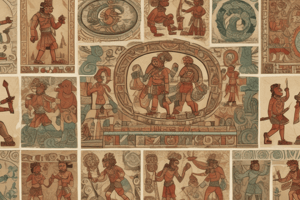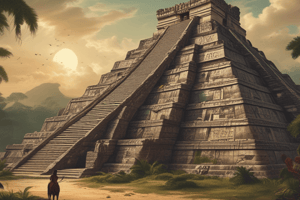Podcast
Questions and Answers
Mayan culture flourished in the region known as?
Mayan culture flourished in the region known as?
Mesoamerica
The first Mesoamericans to use a solar calendar were the?
The first Mesoamericans to use a solar calendar were the?
Olmecs
The Mayas developed their own system of hieroglyphic writing during the _____
The Mayas developed their own system of hieroglyphic writing during the _____
Pre-Classic period
Tikal, Copan, Chichén Itzá, and Palenque are four major Mayan?
Tikal, Copan, Chichén Itzá, and Palenque are four major Mayan?
Where did Mayan cities continue to prosper during the Post-Classic period?
Where did Mayan cities continue to prosper during the Post-Classic period?
Who was at the top of the social pyramid in each Mayan city-state?
Who was at the top of the social pyramid in each Mayan city-state?
Which members of Mayan society knew how to read and write?
Which members of Mayan society knew how to read and write?
Mayan traders traveled by sea, river, and well-constructed roads to trade with other city-states.
Mayan traders traveled by sea, river, and well-constructed roads to trade with other city-states.
Who were considered the backbone of Mayan society because they grew most of the food?
Who were considered the backbone of Mayan society because they grew most of the food?
When might slaves be sacrificed to the gods?
When might slaves be sacrificed to the gods?
Women and girls prepared the food and cared for the home.
Women and girls prepared the food and cared for the home.
What happened at the ceremony that marked the birth of a child?
What happened at the ceremony that marked the birth of a child?
Why did boys wear a white bead in their hair and girls wear a string of red shells around their waists?
Why did boys wear a white bead in their hair and girls wear a string of red shells around their waists?
When arranging a marriage of their children, the families had to agree on?
When arranging a marriage of their children, the families had to agree on?
Why did the Mayas build their cities around religious and ceremonial centers?
Why did the Mayas build their cities around religious and ceremonial centers?
Why did the Mayas honor their gods?
Why did the Mayas honor their gods?
Priests used the Sacred Round to?
Priests used the Sacred Round to?
The primary Mayan food was?
The primary Mayan food was?
How did Mayan farmers adapt to the environment of the mountainous highlands?
How did Mayan farmers adapt to the environment of the mountainous highlands?
What happened by 900 C.E. that marked the end of the Classic period of Mayan history?
What happened by 900 C.E. that marked the end of the Classic period of Mayan history?
This Mayan palace was built in Labná toward the end of the Classic period, which ended about?
This Mayan palace was built in Labná toward the end of the Classic period, which ended about?
Mesoamerica is in what present-day countries?
Mesoamerica is in what present-day countries?
The Pre-Classic period lasted from about _____
The Pre-Classic period lasted from about _____
What happened during the Pre-Classical period?
What happened during the Pre-Classical period?
The Classic period was from _____ until _____
The Classic period was from _____ until _____
What did the Mayas achieve during the Classic period?
What did the Mayas achieve during the Classic period?
The Post-Classic period lasted from _____ until _____
The Post-Classic period lasted from _____ until _____
What happened during the Post-Classical period?
What happened during the Post-Classical period?
What were the ruler's jobs, religious connections, and what was to happen when they died?
What were the ruler's jobs, religious connections, and what was to happen when they died?
Could the ruler be a female?
Could the ruler be a female?
What were the duties of the Mayan women?
What were the duties of the Mayan women?
Flashcards are hidden until you start studying
Study Notes
Mayan Culture and Society
- Mayan culture thrived in Mesoamerica, a culturally rich region encompassing parts of southern Mexico and Central America.
- The Olmecs were the first Mesoamericans to implement a solar calendar, showcasing early advancements in timekeeping.
- The Pre-Classic period saw the development of a unique hieroglyphic writing system by the Mayans.
Major Mayan Cities
- Notable Mayan cities included Tikal, Copan, Chichén Itzá, and Palenque, each serving as significant cultural and political centers.
- During the Post-Classic period, Mayan cities continued to flourish primarily on the Yucatán Peninsula.
Social Structure and Roles
- The social hierarchy was led by a ruler at the top of each city-state, supported by nobles and priests, who were also the literate members of society.
- Peasants formed the backbone of Mayan society, responsible for agricultural production, while women typically managed household duties.
Trade and Economy
- Mayan traders utilized a network of sea routes, rivers, and well-constructed roads for commerce with neighboring city-states.
- The agricultural economy relied heavily on corn as the primary food source, supplemented by other crops.
Religious Practices
- Ceremonial practices were integral to Mayan life, where priests forecasted futures during childbirth ceremonies and often conducted sacrifices, including the possible sacrifice of slaves upon their owners' deaths.
- Religious observance was crucial; gods were honored due to the belief that they could destroy the world they created.
Calendar and Astronomy
- The Sacred Round was a pivotal tool for priests in determining auspicious days for various activities, including planting and religious events.
- Advancements in astronomy allowed the Mayans to create detailed calendars, charting celestial movements and contributing to agricultural planning.
Key Historical Periods
- The Pre-Classic period (2000 B.C.E. to 300 C.E.) was characterized by initial agricultural practices and simple housing structures.
- The Classic period (300 to 900 C.E.) marked a cultural peak with the construction of large cities, temple-pyramids, and observatories.
- By 900 C.E., the Classic period ended as many Mayan cities were abandoned, leading into the Post-Classic period (900 to 1500 C.E.) where cultural achievements decline amidst ongoing warfare.
Rulership and Governance
- Mayan rulers were seen as god-kings, wielding the power to instigate warfare and govern with a council of advisers. Succession typically fell to a male relative upon the ruler's death.
- Although predominantly male, some women exerted significant influence in Mayan governance through familial ties.
Cultural Practices and Traditions
- Symbols of innocence in children included a white bead in boys' hair and a string of red shells for girls during their upbringing.
- Marriages required agreements on the duration of labor the groom would provide to the bride's family, reflecting economic and social arrangements.
Studying That Suits You
Use AI to generate personalized quizzes and flashcards to suit your learning preferences.




